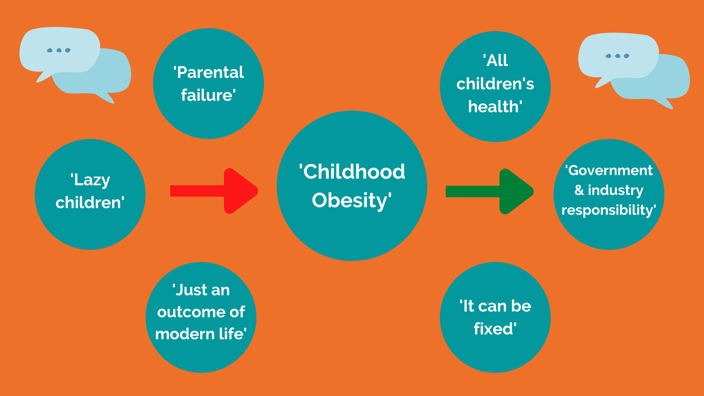Framing Health Issues: How our language can help create change
20 July 2022
When you hear the words ‘childhood obesity’ what immediately comes to mind? Perhaps you think of a food system that has failed young people, or jump straight to the idea that parents must be doing something wrong. It’s likely that one or more themes came to mind without you even having to try. In psychology these instant connections we make with certain issues are known as mental shortcuts; they represent our natural assumptions about the world and are activated by the things we see and hear. Virtually no effort is required for these thoughts to spring to mind because they are deeply ingrained in us and our environments.
In the case of childhood obesity, mental shortcuts which are negative and misguided often persist and this can get in the way of finding solutions to the problem. Common mental shortcuts around the issue include thoughts that it’s the result of individual and parental failure, and that it’s an unfortunate outcome of modern lifestyles that cannot be fixed. Such deeply-held beliefs can make it difficult for people, and importantly policymakers, to properly acknowledge the wider context of the issue (which is where the solutions can be found). And that’s the crucial word in this area – context. Many people are not aware of the variety of factors that can cause childhood obesity and the nature of these mental shortcuts reflect that. However, by using certain framing and language techniques we can paint a more complete picture of childhood obesity which can strengthen support for solutions.
Framing Recommendations
Research by Frameworks UK and Impact on Urban Health identified four key recommendations for discussing childhood obesity and framing the issue in certain ways to increase support for change. Their recommendations below are designed to avoid negative mental shortcuts and help people to understand the full context of the issue.
- Lead with children’s health (not obesity)
The most important recommendation to come out of the research is to avoid using the words ‘childhood obesity’, and instead highlight children’s overall health when raising the issue. By focusing our conversations around children’s overall health, we can completely avoid the negative shortcuts that come to mind with the words ‘childhood obesity’. The issue of obesity then becomes implicit in the ‘overall health’ frame. This creates a narrative where health is something that all children have in common and avoids excluding children with obesity who are often seen as outsiders in conversations about health. The research shows that support for societal and policy change increases significantly when leading with health as opposed to obesity.
- Appeal to the need to meet children’s needs, no matter where they live.
This recommendation allows us to frame inequality in a way that everyone can easily understand. We need to communicate the fact that children’s health (including their likelihood of developing obesity) is largely determined by where they live, play and go to school – none of which are within a child’s control. We need to emphasise that this isn’t fair and that all children deserve the same chance to be healthy.
- Explain how what surrounds us, shapes us.
This is the vital context that allows people to better understand the complex nature of childhood obesity. To tell the full story, it’s important to communicate the role that the government and food industry have in addressing the problem, and shift the blame away from children and parents. We need to explain what the food environment really is and how it is heavily skewed towards unhealthy options which damage children’s health. This might include mentioning typical prices and promotions of unhealthy foods compared to healthy foods. It’s also important to mention the constant advertising that children are exposed to, again comparing it to the virtually non-existent advertising for healthy eating.

- Emphasise the potential for change, not just the need for it.
Finally, when concluding our story, we need to finish on a positive note. We have explained the situation in a way that provides context and increases support for change, and we now need to explicitly highlight that change is possible. This could be done by referring back to pieces of the context explained earlier (e.g. children are constantly exposed to junk food ads on billboards) and explaining how it can be improved (e.g. junk food regulations put in place by government should be extended to outdoor settings). This positive end note helps build the support and drive for solutions.
The Pandemic Momentum
Some additional research by the same groups revealed that the COVID-19 pandemic has raised public awareness around inequalities and the link between deprivation and obesity. This is an important development for public health campaigners who are encouraged to reference the impact of the pandemic in discussions. While still leading with children’s health, there is now the opportunity to use the pandemic to help explain the context of the problem. This might include highlighting increased sedentary behaviour of children as a result of lockdowns, or the constant advertising they were exposed to due to them being on social media more often.
This research presents a unique tool to campaigners for child health. While real and tangible change will only come from policy decisions on the ground, the way we talk about about these policies to raise support for them is a crucial first step. Our team at Obesity Action Scotland have learned and discussed the research and will aim to implement it where appropriate in our communications.
This blog discusses research published by Impact on Urban Health UK and Frameworks which can be found in full here.
 Weight Stigma
Weight Stigma
 Children and Young People
Children and Young People